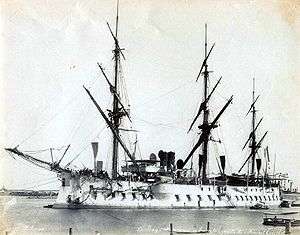French ironclad Bayard
 Bayard crossing the Suez Canal at Port Said while bringing the remains of Admiral Amédée Courbet back to France. Her spars are set diagonally, one mast perpendicular to another, as a sign of mourning. | |
| History | |
|---|---|
| Name: | Bayard |
| Namesake: | Pierre Terrail, seigneur de Bayard |
| Builder: | Brest. Plan by Sabattier and Lebelin de Dionne |
| Laid down: | 19 September 1876 |
| Launched: | 27 March 1880 |
| Commissioned: | November 1882 in Brest |
| In service: | May 1883 |
| Fate: | Broken up in 1910 |
| General characteristics | |
| Class and type: | Bayard-class ironclad |
| Displacement: | 6000 tonnes |
| Length: | 81 m (266 ft) |
| Beam: | 17.45 m (57.3 ft) |
| Draught: | 7.75 m (25.4 ft) |
| Installed power: | 4,500 shp (3,400 kW) |
| Propulsion: |
|
| Sail plan: | 3 masted, squared rig |
| Speed: | 14.5 knots (26.9 km/h; 16.7 mph) |
| Range: | 3,600 nmi (6,700 km; 4,100 mi) |
| Complement: | 450 |
| Armament: |
|
| Armour: | |
The French ironclad Bayard was an early stationary battleship of the French Navy, lead ship of her class. Bayard had a wooden hull and a full rigging, as well as a side armour and steam machinery.
Active service
Bayard was commissioned in May 1883 under the command of capitaine de vaisseau Parrayon as the flagship of Admiral Amédée Courbet, who had recently been appointed to the command of France's Trial division (division des essais), established in April 1883. On 31 May 1883, in the wake of the defeat and death of Commandant Henri Rivière in Tonkin (northern Vietnam) at the Battle of Paper Bridge, Courbet was placed in command of a newly created Tonkin Coasts naval division. In early June Courbet left for the Far East with the ironclads Bayard and Atalante and the cruiser Châteaurenault.[1]
Bayard arrived in Along Bay on 10 July, and for the next eleven months served as flagship of the Tonkin Coasts naval division.[2] In August 1883, in the Battle of Thuan An, she bombarded the coastal defences of Hué, receiving minor shot damage from the Vietnamese shore batteries.[3] From October 1883 to June 1884, during the period of growing tension that preceded the outbreak of the Sino-French War (August 1884–April 1885), she took part in a French naval blockade of the coast of Tonkin. On 30 November 1883, in response to the threat of an imminent Vietnamese attack on the French post at Quang Yen, Bayard's landing company was hastily installed in the town's citadel, successfully deterring the threatened attack.[4] In June 1884 Bayard became the flagship of the Far East Squadron, an exceptional naval grouping created for the war with China by the amalgamation of the Tonkin Coasts and Far East naval divisions.[5]
On 5 August 1884 sailors from Bayard took part in a French landing at Keelung, but were forced to re-embark on 6 August by a heavy Chinese counterattack.[6] Bayard took no part in the Battle of Fuzhou (23 August 1884), the opening battle of the Sino-French War, as she drew too much water to enter the Min River. Instead, she was left to guard the telegraph station at Sharp Peak near Matsu that allowed the squadron to communicate with France.[7] On 1 October 1884 Bayard and several other French warships supported the French landing at Keelung with a naval bombardment of Chinese shore positions.[8] On 8 October Bayard's landing company took part in the failed French landing at Tamsui, which condemned the Formosa expeditionary corps to a prolonged Keelung Campaign.[9] From November 1884 to January 1885 Bayard took part in the French naval blockade of Formosa.[10] On 14 November 1884, while anchored off Keelung and exposed to the northeast monsoon, she nearly foundered when her anchor chain snapped during a gale.[11]
In February 1885 five warships of China's Nanyang Fleet made a sortie from Shanghai in an attempt to break the French blockade of Formosa. Courbet sought them out with Bayard and several other ships of the Far East squadron, and trapped them in Shipu Bay. At the Battle of Shipu on the night of 14 February 1885, two of Bayard's launches, used as improvised torpedo boats, attacked the Chinese squadron at anchor and disabled the frigate Yuyuan (馭遠) and the composite sloop Chengqing (澄慶).[12] In early March 1885 Bayard took part in the French blockade of Zhenhai, the outport of Ningbo.[13] In late March she formed part of the French flotilla for the Pescadores Campaign, and her landing company was engaged ashore on 31 March in the decisive battle with the Chinese defenders of Makung.[14]
Admiral Amédée Courbet died on board Bayard in the harbour of Makung, in the Pescadores Islands, on 11 June 1885.[15] Bayard left the Pescadores on 23 June to return Courbet's body to France for a state funeral, arriving at Toulon on 26 August.[16] She then proceeded to Brest to be disarmed and decommissioned. She was eventually used as a hulk from 1899.
Notes
References
| Wikimedia Commons has media related to French battleship Bayard. |
- Loir, M. (1886). L'escadre de l'amiral Courbet, notes et souvenirs. Paris.
- Roche, Jean-Michel. Dictionnaire des Bâtiments de la flotte de guerre française de Colbert à nos jours. tome II.
- Rollet de l'Isle, M. (1886). Au Tonkin et dans les mers de Chine. Paris.